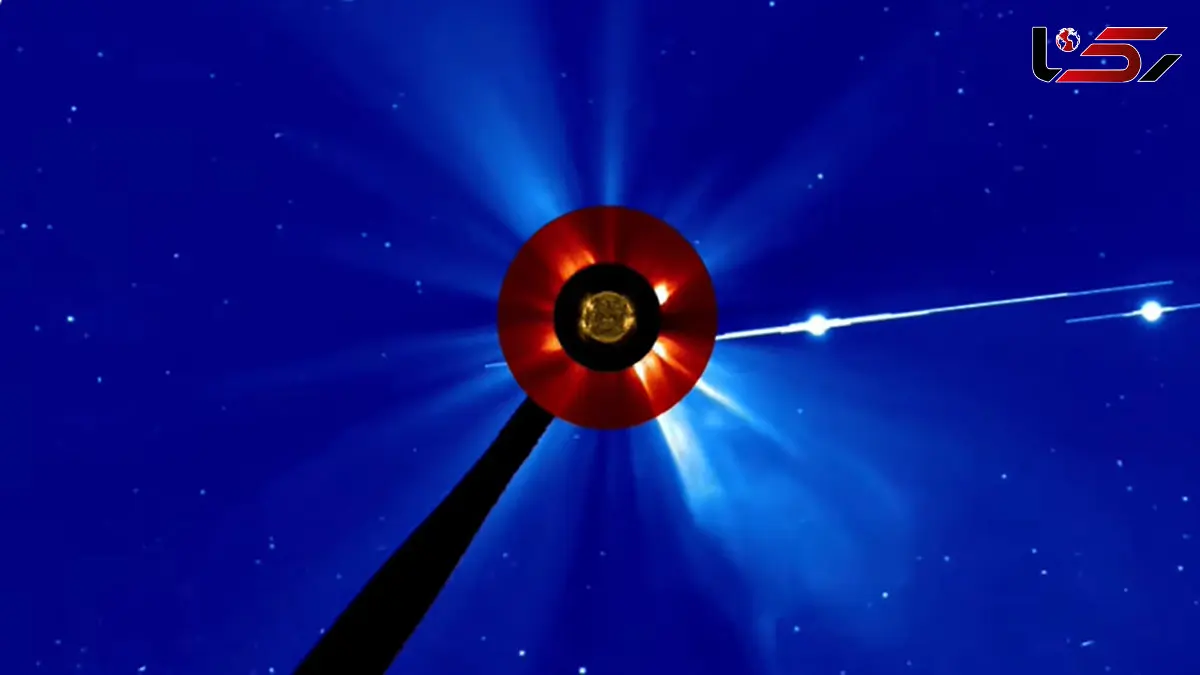Solar storms on our own Sun can generate auroras on Earth/Record Stellar Explosion May Destroy Atmospheres of Nearby Worlds
Rokna Social Desk: A colossal stellar eruption detected for the first time beyond our solar system has revealed a coronal mass ejection so powerful it could strip a nearby planet of its atmosphere, redefining scientists’ understanding of extreme space weather around other stars.

According to Rokna, citing CNN, for the first time, astronomers report detecting a massive outburst emitted by a star outside the solar system. Although the eruption shares some characteristics with those produced by our Sun, such as the solar storms that produced last week’s auroral displays on Earth, this one occurred on a far more dramatic — and potentially threatening — scale.
Instead of generating dazzling lights comparable to the northern auroras, this enormous explosion was far more likely to inflict destructive effects on any nearby planet, according to newly published findings.
Researchers believe the event was triggered by a coronal mass ejection, or CME — a huge cloud of ionized gas, known as plasma, intertwined with magnetic fields, expelled from the outer regions of a star. Within our own solar system, such eruptions from the Sun can disturb Earth’s magnetic field, producing severe space weather. These events ignite auroras but can also interfere with communications, power infrastructure, and satellite systems.
Until now, astronomers had never been able to detect a CME being released from another star. The breakthrough is detailed in a study published Wednesday in Nature.
The star in question, StKM 1-1262, is a red dwarf located roughly 130 light-years away. The stellar outburst blasted outward at an extraordinary 5.3 million miles per hour (2,400 kilometers per second) — a velocity seen in only about one in every 2,000 solar CMEs, the study notes.
“The star behaves like an extremely magnetized, boiling cauldron of plasma. This burst is between 10,000 and 100,000 times more powerful than the strongest events our Sun can produce,” said study coauthor Cyril Tasse, a research associate at the Paris Observatory. “It opens a new window into extrasolar space weather.”
The dense, fast-moving material expelled from the star was so powerful that it could effectively strip the atmosphere from any planet orbiting too closely.
Understanding how such violent stellar activity shapes exoplanets is essential as scientists assess whether any worlds beyond the solar system may support life.
As they travel outward, CMEs generate intense radio emissions while crossing the star’s corona, the outermost layer of its atmosphere.
“These are strong blasts of stellar wind moving faster than the speed of sound in surrounding interplanetary space, creating shock waves similar to the sonic boom of a fighter jet,” said Mark Miesch, a scientist at NOAA’s Space Weather Prediction Center, who was not involved in the research.
The radio signal was found by scanning sky-survey data collected a decade ago by the Low Frequency Array (LOFAR) radio telescope, which consists of thousands of antennas across the Netherlands and Europe.
“Such a radio signal simply couldn’t exist unless the material had fully escaped the star’s magnetic bubble,” said lead author Dr. Joe Callingham of the University of Amsterdam. “In other words, it indicates a CME.”
To detect the signal, Tasse and coauthor Philippe Zarka developed a new analytic method called Radio Interferometric Multiplexed Spectroscopy (RIMS), which tracks fluctuations in starlight across thousands of stars.
“This technique is ideal for identifying CMEs that evolve over just minutes, requiring continuous, high-time-resolution monitoring,” Tasse explained.
RIMS detected a type II radio burst — a sign that heated plasma was moving outward into space. Unlike fast radio bursts, which last mere milliseconds, these emissions continue for several minutes.
“The signal tells us not only that the star expelled mass, but also allows us to estimate physical characteristics such as density,” Callingham said.
The team used X-ray measurements from the European Space Agency’s XMM-Newton mission to determine the star’s temperature, rotation, and brightness. LOFAR and XMM-Newton were both essential to confirming the CME’s motion and placing it in a solar context.
Detecting CMEs from distant stars has been extremely difficult because they are too far away to observe directly. Although earlier hints existed, they could often be attributed to other forms of stellar activity, making this the clearest evidence to date.
“This detection is likely the strongest indication so far that CMEs occur beyond our solar system,” said Kevin France, an astrophysicist at the University of Colorado Boulder.
Red dwarf stars often possess magnetic fields far stronger than the Sun’s. StKM 1-1262, which has half the Sun’s mass, rotates 20 times more quickly and appears to have a magnetic field roughly 300 times as strong.
Such stars commonly host planets — sometimes orbiting so closely that they complete a full orbit in just days. But scientists question whether the intense radiation and flares of red dwarfs could strip such planets of their atmospheres, rendering them uninhabitable.
While no planets have yet been detected around StKM 1-1262, nearly all red dwarfs appear to harbor at least one. Callingham noted that even a planet located in the star’s habitable zone would likely struggle to retain its atmosphere under such extreme conditions.
Looking ahead, researchers aim to understand how these small stars generate such immense eruptions and what repeated CMEs could mean for nearby planets.
Future work may be supported by the Square Kilometre Array, expected to become the world’s largest radio telescope when completed in 2028. It may help uncover additional CMEs from other stars.
“This is just the beginning,” Miesch said. “It should motivate follow-up studies to confirm our interpretation and to determine how common these events truly are.”
Send Comments